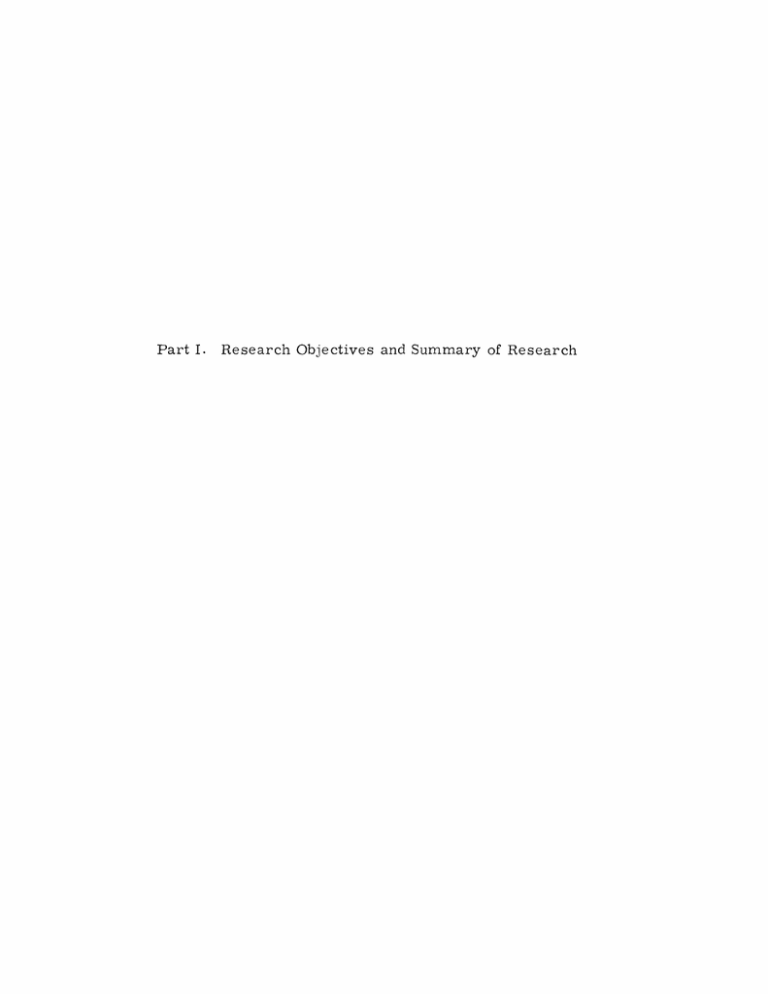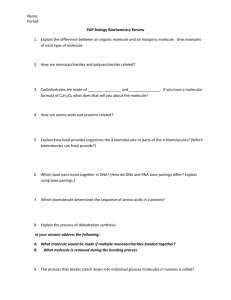Part I.
advertisement

Part I. Research Objectives and Summary of Research 0 , 'L GENERAL PHYSICS I. MOLECULE MICROSCOPY Academic and Research Staff Prof. John G. King Dr. John W. Peterson Dr. Stanley Rosenthal Dr. James C. Weaver Jerome Abrams Graduate Students H. Frederick Dylla Joseph A. Jarrell Dusan G. Lysy Bruce R. Silver Peter W. Stephens Joint Services Electronics Program (Contract DAAB07-75-C-1346) National Institutes of Health (Grants 5 S05 RR07047-10, and 1 RO1 GM22633-01) JSEP 5 PO1 HL14322-04, John G. King, James C. Weaver Our program of development of molecule microscopy, a new form of microscopy in which neutral molecules, rather than photons or electrically charged particles, carry the image generated from the sample continues. The basic motivation for molecule microscopy is that neutral molecules are particularly well suited for probing surface interactions based on the chemistry of a sample surface. For this reason, molecule micrographs should provide contrast based on spatial variations of permeability, diffusion, binding of neutral molecules, and even spatial distribution of enzymes in certain samples. Thus properties that are not directly accessible in the conventional forms of microscopy can be mapped spatially with a molecule microscope. Since molecule microscopy can have many applications in a variety of fields, we have sought developmental support from both physical and life sciences. The Joint Services Electronics Program has supported aspects of molecule microscopy related to surface interactions in electronically relevant materials, while the National Institutes of Health has supported work with ultimate applications to biological and biomaterials surfaces. Our recent work on the volatile enzyme product method, an outgrowth of molecule microscopy, is supported entirely by the National Institutes of Health. 1. Scanning Pinhole Molecule Microscopy (SPMM) The initial construction phase of the second generation SPMM has been completed by J. A. Jarrell. The apparatus is being used, in collaboration with Dr. John W. Peterson, to study vascular smooth muscle (VSM). In these experiments the spatial resolution capability will not be used. Considerable effort has been expended to improve various aspects of the apparatus, in particular the long-term stability of the mass spectrometer, so that oxygen consumption and CO 2 production by a VSM sample can be monitored in a small vessel while the sample is stimulated in a variety of ways. We anticipate that applications with spatial resolution will soon be initiated. One application is the study of grain boundaries in metallic samples; another is the measurement of enzyme distributions in tissue without staining or fixing the sample. 2. Scanning Desorption Molecule Microscopy (SDMM) During the past six months H. Frederick Dylla completed his doctoral thesis based on the construction and development of the prototype SDMM and has obtained preliminary results on the adsorption and desorption of CO, as well as of other species, from silicon(1ll) crystals. Since the prototype SDMM has been supported both by the Joint PR No. 117 JSEP (I. JSEP MOLECULE MICROSCOPY) Services Electronics Program and the National Institutes of Health, we expect now to begin application of this instrument to problems of both electronics materials and biological surfaces. 3. Desorption Experiments Related to SDMM Preliminary results have been obtained on the binding of water to two initial samples, bovine serum albumin (BSA) and soluble starch, using techniques similar to These data indithose described by D. G. Lysy in Progress Report No. 115 (pp. 5-9). cate that water binds to the biomolecules in some states with binding energies in the range 15-17 kcal/mole and 25-35 kcal/mole. Three important results have been established: (i) The water desorption peaks are reproducible and are due to the biomolecules. (ii) Different biomolecules give different water desorption peaks. This is important for SDMM, since this is one source of contrast in this mode of the technique. (iii) The highenergy peaks have not been previously observed, to our knowledge, although they have often been postulated by physical chemists, based on simple dipole-dipole interaction energy considerations. 4. Molecule Fluxes through Tissue In 1974, we obtained a small reallocation grant under the Harvard-MIT Program in Health Sciences and Technology to begin an interdisciplinary study in which mass spectrometry techniques were to be applied to the study of volatile fluxes such as 02 and CO Z from epithelial tissues. This work has now advanced to the stage where Dr. Stanley Rosenthal has constructed an apparatus in the Molecular Beams laboratory and, after initial calibration runs and some modifications, has taken it to the laboratory of Dr. Alvin Essig at Boston University Medical School. There he has continued to work with system improvement and noise reduction and has begun to obtain preliminary results on the oxygen consumption and CO 2 production from frog skin. 5. Volatile Enzyme Product Technique During the past year an apparatus has been designed and almost completed for the study and development of the volatile enzyme product (VEP) technique. A custom highvacuum system and associated apparatus have been fabricated and partially tested. Recently, Jerome Abrams has joined us to work on this project and progress has been made to the point where permeability, degassing, and enzyme measurement runs are now beginning. We have previously collaborated in these studies with Prof. Charles L. Cooney, of the Department of Nutrition and Food Science, M. I. T. Now we also expect to collaborate with Dr. Edward R. Gruberg, Dr. Stephen A. Raymond, and Prof. Jerome Y. Lettvin, of the Neurophysiology Group of the Research Laboratory of Electronics, and with Prof. Steven R. Tannenbaum and his colleagues in the Department of Nutrition and Food Science, M. I. T. In this work we expect to apply the VEP method to the study of JSEP enzymes in tissue that has been either ground up or not ground up. PR No. 117










